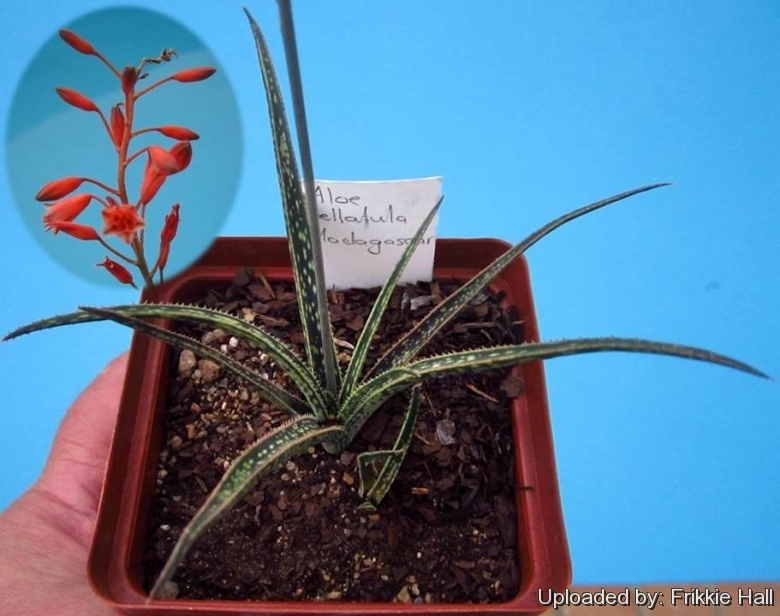




Your support is critical to our success.

Origin and Habitat: Fianarantsoa in the Itremo Mountains of Madagascar.
Altitude range: Around 1500 metres above sea level.
Habitat and ecology. Aloe bellatulaSN|31622]]SN|31622]] can be found growing on Granite outcrops on mountain slopes.
Synonyms:
- Aloe bellatula Reynolds
- Guillauminia bellatula (Reynolds) P.V.Heath
RUSSIAN (Русский): Алоэ красивое
UKRAINIAN (Українська): Алое миловидне, Алое привабливе
Description: Aloe bellatulaSN|28235]]SN|31622]] is a small stemless and suckering species forming dense fleshy clump of upright leaves. It is distinguished by having thin leaves, up to 13 cm long, with the upperside slightly grooved. Although both surfaces of the leaves are covered with rough papillae, they are very flexible. Tiny, pale teeth along the leaf margins make them feel rough rather than sharp. The flowers are pendulous, bright coral-red, long, bell-shaped on the end of a long stalk.
Derivation of specific name: For its beauty, from Latin ‘bellus’ (beautiful), diminutive.
Rosettes: Stemless with about 16 leaves, off-setting freely at their base to form dense clumps.
Leaves: Linear, but tapering, succulent, each 100-130 cm long and 9-10 mm wide, dark green becoming bronzed in strong light, with copious, pale green, lens-shaped spots 0.5 x l mm on both surfaces. The leaves are incurved with the upper slightly channelled, a convex lower and a rough warty surface. Marginal teeth, triangular 1 mm long, soft, cartilaginous, l mm apart, smaller or absent towards apex.
Inflorescence (Raceme): There are 2-3, stems about 60 cm high rising well above the foliage of the plant, which may be simple or rarely branched. Flowers about 35 per inflorescence. Flower-stalks about 1.2 cm, bracts 4-6 mm.
Flowers: Perianth about 1.3 cm, cylindric to bell-shaped, hanging laxly downwards, vivid coral-red to orange-red with whitish interiors, a combination which makes the flowers appear pinkish from a slight distance. Outer lobes free for little more than half their length. Anthers and style scarcely projecting.
Similar species: Maybe Aloe bellatulaSN|31622]]SN|31622]] is the same plant as Aloe perrieriSN|12234]]SN|12234]], a very similar plant from somewhat lower elevation on a neighboring mountain. Aloe bellatulaSN|31622]]SN|31622]] is also similar to Aloe albifloraSN|31622]]SN|28235]] for leaves only.
is a choice, tender plant from Madagascar, growing at elevations of around 4500 ft.
Chromosome number. 2n = 14.
Bibliography: Major references and further lectures
1) Raewyn Adams “Aloes A to Z” Lulu.com, 2015
2) Urs Eggli “Illustrated Handbook of Succulent Plants: Monocotyledons: Monocotyledons” Springer Science & Business Media, 17 July 2001
3) Werner Rauh “The Wonderful World of Succulents: Cultivation and Description of Selected Succulent Plants Other Than Cacti” Smithsonian Institution Press, 1984
4) Aloe bellatula in: “Light Garden”, Volumes 16-18 Indoor Light Gardening Society of America, 1979
5) Reynolds, “Aloes of tropical Africa”, t. 89 & 407-9, 1966
6) James Cullen, Sabina G. Knees, H. Suzanne Cubey “The European Garden Flora Flowering Plants:A Manual for the Identification of Plants Cultivated in Europe, Both Out-of-Doors and Under Glass” Cambridge University Press, 11/ago/2011
7) R.J. Hodgkiss “The Aloe Page” retrieved 15 May 2016 from <http://www.succulent-plant.com/families/aloaceae.html>
8) S. Carter, L. E. Newton, J. J. Lavranos, C. C. Walker “Aloes: The Definitive Guide” August 2011
9) Olwen M. Grace, Ronell R. Klopper, Estrela Figueiredo & Gideon F. Smith “The aloes names book” Strelitzia 28 (2011) South African national biodiversity institute SANBI
Cultivation and Propagation: Aloe bellatulaSN|31622]]SN|31622]] is is easy to grow on a sunny window-ledge. It flowers freely in winter. It blooms as a 2- to 3- year-old seedling, and is a very pretty and recommendable species.
Light requirements: Full sun in general or light shade summer.
Water requirements: Keep relatively dry, careful watering is required, as it is prone to rot if overwatered, especially in the winter months.
Hardiness: Tender, frost protection is required keep it at or around 5°-10°C in winter.
Propagation: Via offsets or seeds.
| Your Actions | |
|---|---|
| Back to Aloe index | |
| Back to Aloaceae index | |
 |
Back to Succulents Encyclopedia index |
Privacy stantement - Terms and conditions - How to cite - About us - Feedback - Donate




